It’s late at night, and you’re sitting in your home office, surrounded by piles of paperwork and a growing list of client emails. You’ve hustled hard to get your business off the ground, and it’s finally starting to pay off.
But now you wonder, how can you take this to the next level without burning out?
You’re not alone in feeling this way. Many solopreneurs hit this crossroads, especially in 2025, when the opportunities for growth are endless, yet so are the challenges.
The good news? Scaling doesn’t have to mean sacrificing your sanity. With the right strategies and tools, you can streamline your operations, expand your reach, and maintain the personal touch that makes your services stand out.
The State of Solopreneurship in 2025
Solopreneurship is having a major moment for the last couple of years. The pandemic and rising inflation nudged many people to start their own businesses, and they stayed on for the independence and flexibility it offers.
| The number of freelancers in the US is projected to shoot up to 86.7 million, which will make up 50.9% of the total US workforce. (Statista) |
The Entrepreneurship in 2025 survey (commissioned by Intuit QuickBooks) reveals that increasing revenue is the #1 goal for 42% of solopreneurs.
On average, a solopreneur works about 40 hours a week, which is less than business owners with employees (45 hours a week).
However, 35% of solopreneurs report high stress levels compared to 26% of employers, despite having more flexibility and working fewer hours.
These numbers offer some food for thought. While the aim for growth is inspiring, solopreneurs have to be proactive and manage their workload better. More so if you’re from the creative industry, because stress and creativity can never go hand-in-hand.
Define What Scaling Up Means for You
Growth can have a different meaning for different people. Take a moment to understand your definition of scaling up, so you can take the next steps accordingly.
Generally, scaling a business can mean any of the following (or all of them!):
- Expanding your services: You want to add new offerings to your portfolio. By diversifying your services, you can attract more clients, and potentially increase your income. If you’re a consultant, for example, you might start offering workshops or create digital products like e-books
- Increasing your average order value (AOV): You want clients to spend more per transaction. To achieve this, you can upgrade your existing rate chart, introduce premium services, package your services with add-ons, or upsell complementary services
- Onboarding more clients: You want to increase the number of clients you work with. It’s tricky because you’re a solopreneur and there’s a limit to how much of a workload you can manage alone. To accommodate more clients, you need to build solid systems to handle multiple projects at one go, without compromising on quality
Also read: 7-Step Guide to Building the Perfect System for Your Freelance Business
Take Your Freelance Business to New Heights: Tips for Solopreneurs
Since you’re not starting from scratch, we’ll skip the basics. Here are 6 actionable tips to reshape your strategy and scale your freelance business.
1. Double Down on Social Media and Digital Marketing
If you’ve been operating your business for a while, chances are, you already have an established internet presence. But you don’t want to stay stuck—your goal is to take your business far ahead. For that, you need to amplify your efforts and make social media and digital marketing your strongest ally.
Solidify your online presence
- Establish a consistent brand identity: Whether you prefer your website or social media profiles for lead generation, make sure you maintain a consistent brand image across platforms, in terms of the look, feel, and core messaging
- Engage with your audience: Use social media to build meaningful connections. Respond to comments, answer messages, and join conversations. Create a community around your brand
- Share valuable content: People follow you because they find your content valuable. Whether it’s through blog posts, videos, infographics, or personal opinions, make sure you’re offering something your audience cares about
- Leverage different platforms: Different platforms serve different purposes. Use Instagram for eye-catching visuals, LinkedIn for networking and professional updates, Twitter for quick and real-time updates, and so on
Invest in social media ads
| According to a SproutSocial survey, the majority of consumers (53%) are using social media even more today than during the pandemic-era surge. So this is clearly the best time to use socials to your advantage. |
Ads on Facebook, Instagram, LinkedIn, and Twitter can help you reach a wider audience, beyond your existing follower base. Target specific demographics/interests and create tailor-made ads that directly speak to your prospective customers.
For instance, if you’re a photographer, you can target couples for pre-wedding/wedding photography, new parents for baby photoshoots, or small business owners for commercial photography.
Build an email marketing strategy
If you don’t already have one, it’s time to create an email list and build a strong reputation by delivering value-packed newsletters.
- Collect email addresses: Use sign-up forms on your website or social media posts to collect email addresses from prospects. Offer something in return, like a free resource, discount, or exclusive content, to encourage people to sign up
- Segment your audience: Create segmented email content based on your audience’s interests, behavior, or demographics. With this approach, you can send more personalized emails to each group and keep engagement levels up
- Pitch your upsell: After you warm up your subscribers with valuable content, pitch your offer. Even if some prospects are not yet ready to convert, they’ll be aware of exactly how you can help them. They’ll remember you the next time they need that particular service—and that, in itself, is a powerful promotion
2. Use a powerful workflow management software that’s tailored for your business
Most online platforms are designed for small and medium-sized businesses, not for solopreneurs like you. As an independent creative, you’re forced to switch between multiple expensive and hard-to-manage tools for managing admin work and projects.
For example, as a full-time photographer, you’re compelled to use multiple tools to handle different aspects of your business, such as a website builder, lead capture tool, invoicing tool, communication platform, and the list goes on. Your tech stack grows bigger, and so does the complexity of management.
The end result? You’re burnt out and your creativity takes a hit. Instead of growing, your business hits a plateau.
But things don’t need to be so difficult. With the right workflow management software by your side, you can slim down your tech stack while keeping your workflow smooth.
Bloom is one such tool, which specifically caters to creative solopreneurs. It unifies the multiple moving pieces of your business and streamlines task management, so you can focus better on the creative part of your job.
Here’s how you can simplify your business operations with Bloom:
- Use lead capture forms to automatically create new leads and track each opportunity
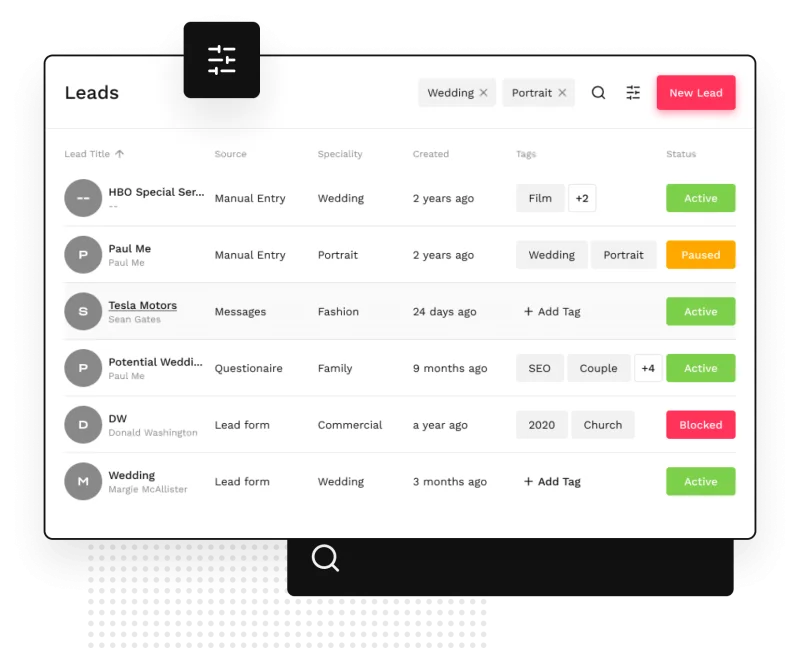
Organize your prospects with Bloom’s lead management solution
- Set statuses (such as active, paused, etc.), create tags, and trigger automated followup emails to manage your leads
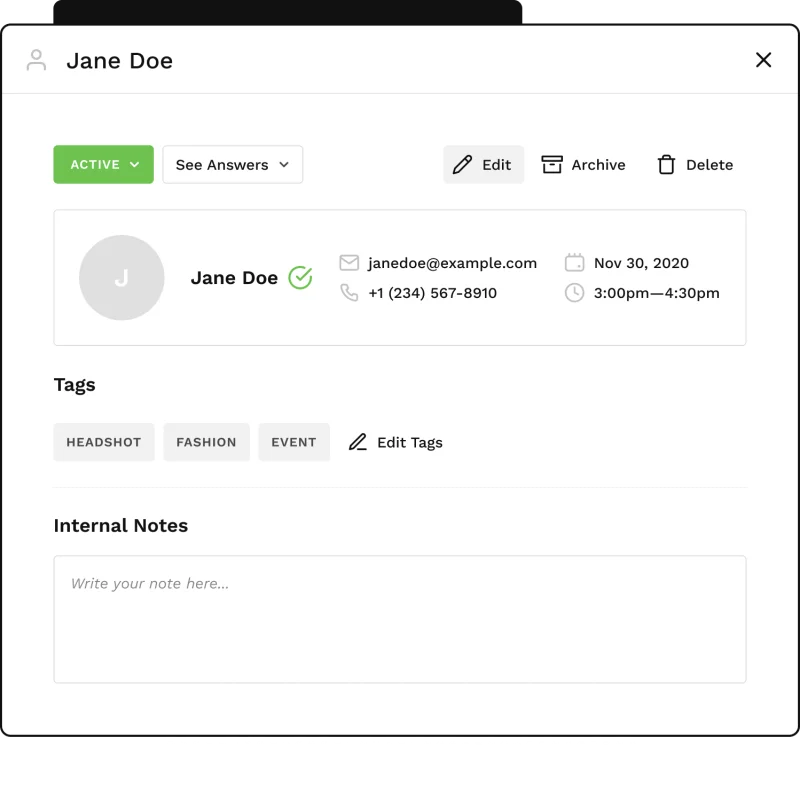
Add details for each lead, such as contact details, internal notes, and related documents
- Create a booking form directly embedded on your website and offer a seamless booking experience
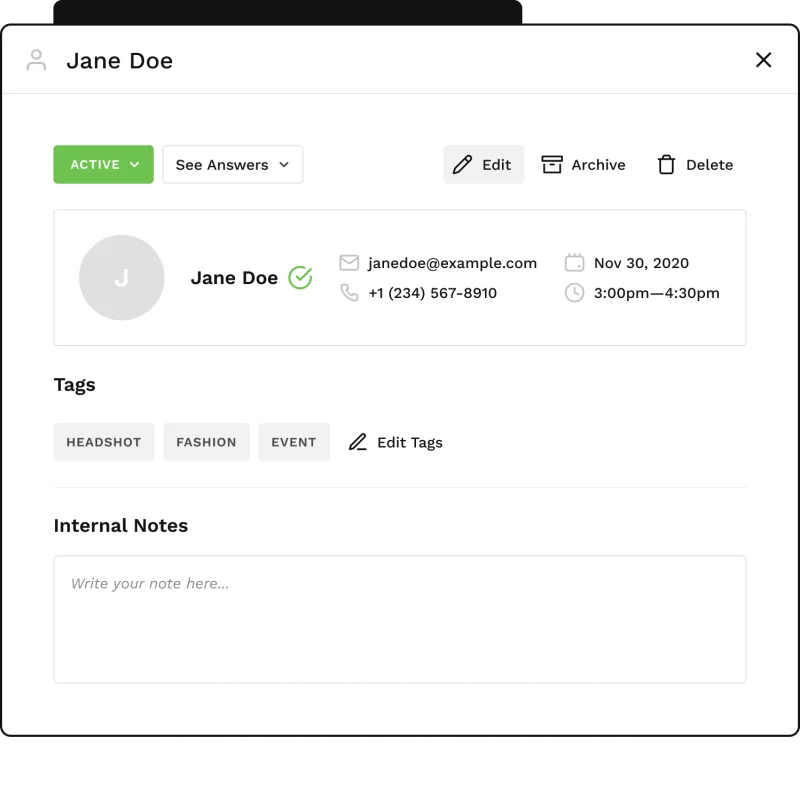
Enable customers to book a service/consultation directly from your website with Bloom’s booking form
- Integrate Google Calendar with Bloom, set custom availability for new projects, block time for existing client projects and other commitments, and stay on top of your schedule
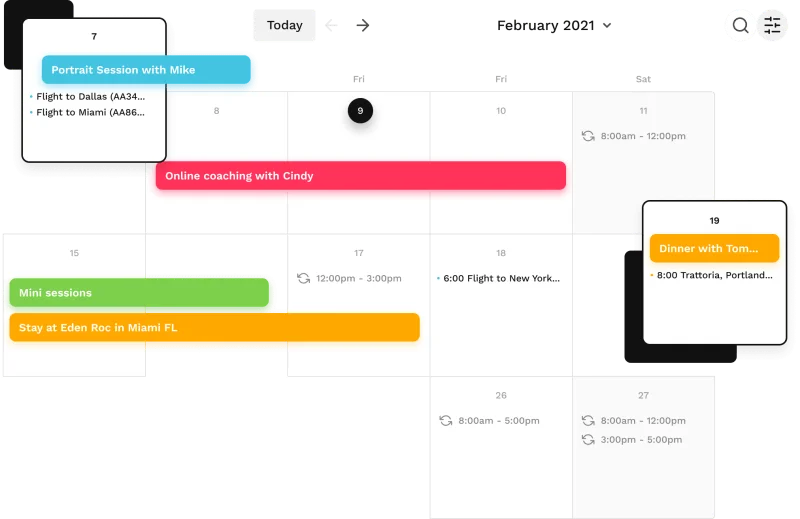
Manage your calendar effectively with Bloom’s scheduling feature
- Set how you’d like to book each kind of project—whether you’d take a deposit, require full amount, or remove the payment option from the booking form
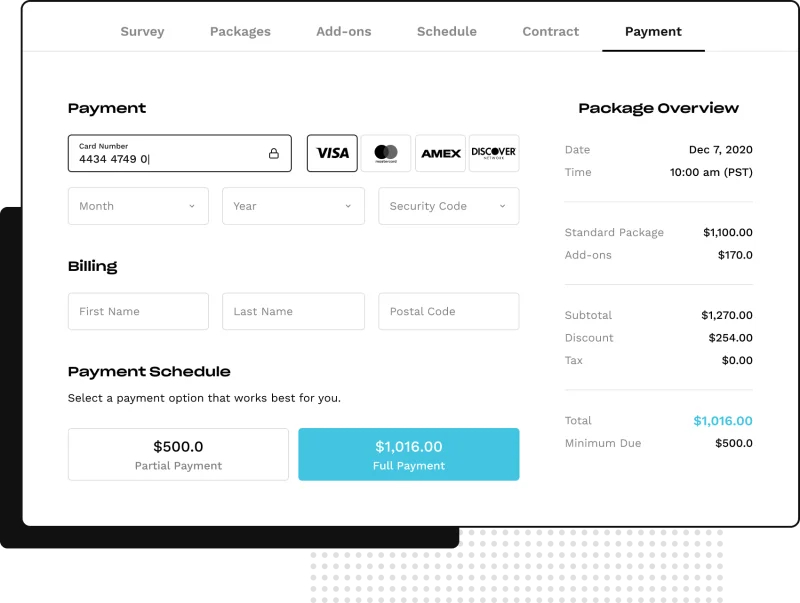
Use Bloom to accommodate different payment setups and meet the requirements of your creative business
- Upload your existing contract PDFs on Bloom or copy and paste into a new template. When booking clients, select the relevant contract(s) and automate all contract signing
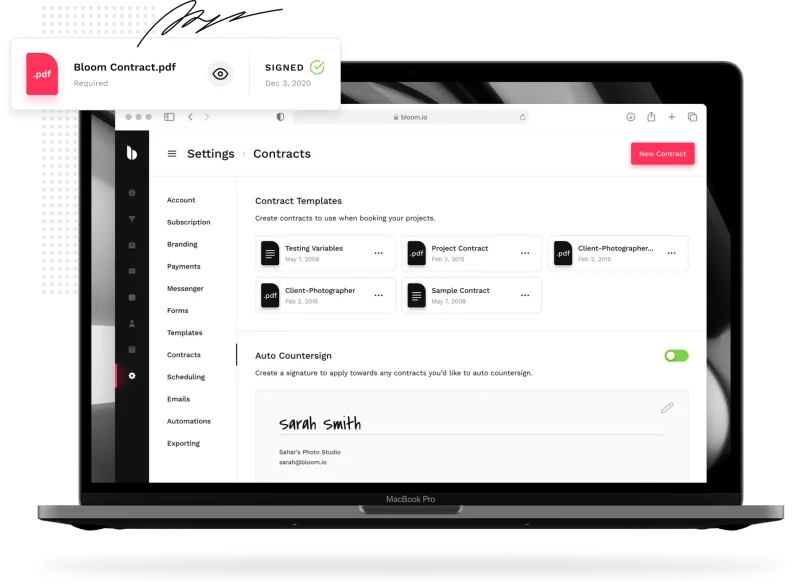
Speed up contract creation and signing with Bloom
- Organize project details (such as contacts, invoices, payments, questionnaires, notes, asset delivery, and project-related documents) under one roof and make your workflow smooth-sailing
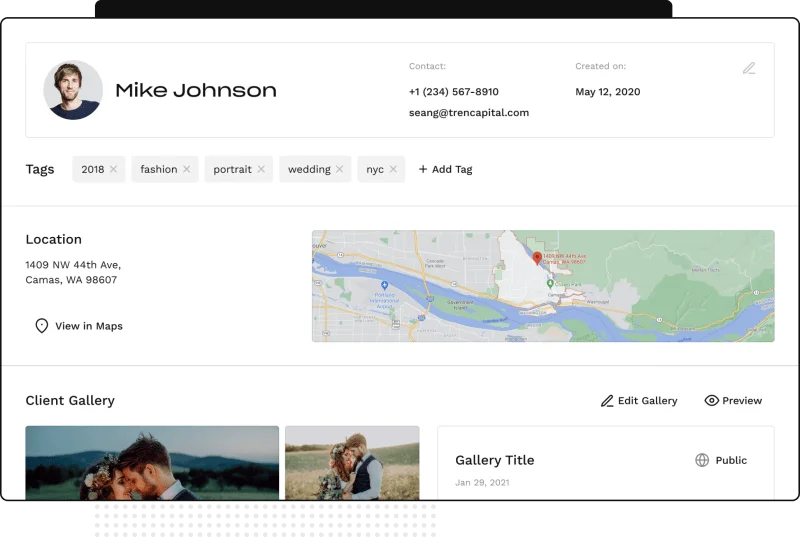
Keep your project assets stored in Bloom’s safe repository and access them whenever you want
- Showcase your work with Bloom’s professional portfolio templates, customize the layouts, domains, and pixel embedding, and add a CTA to drive conversion

Create a stunning website portfolio with Bloom—a great solution for visual artists
- Integrate Bloom with payment solutions such as Cash App, Venmo, Zelle, or PayPal, enable credit card or ACH transfer, add contracts to your invoices, and get paid on time
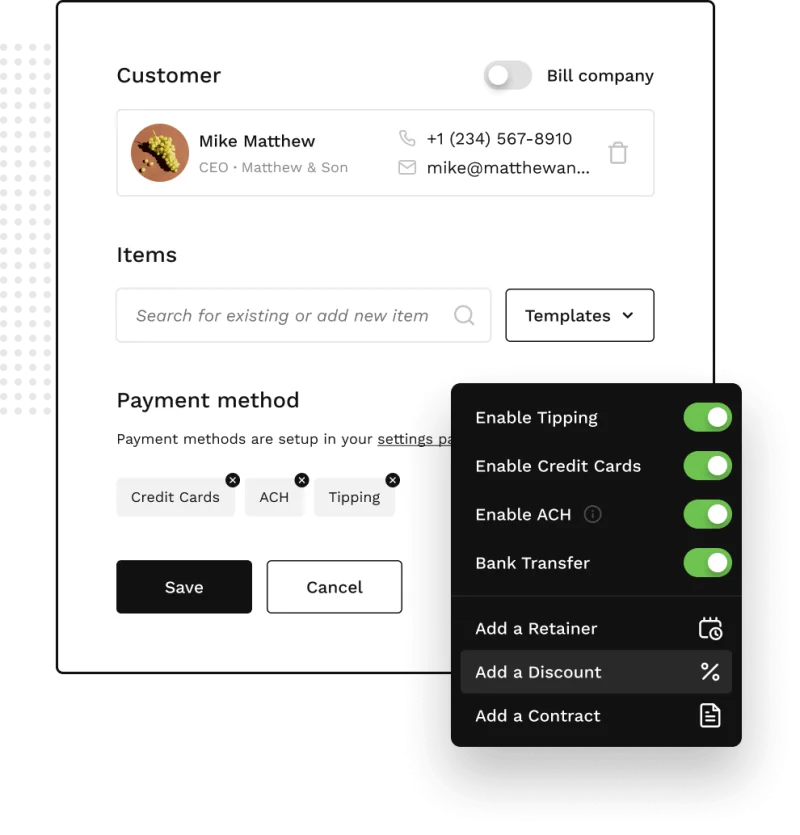
Offer multiple payment methods with Bloom’s invoicing and payments solution and empower customers to pay however they prefer
3. Make discipline a habit
As a solopreneur, you don’t have a manager breathing down your neck to meet deadlines, so you have to be disciplined on your own. Here’s how you can make it a habit:
- Focus on high-value activities: Prioritize tasks that significantly impact your business. Think about the 20% of activities that drive 80% of your results. These high-value tasks should take up most of your time and energy
- Show up daily: Consistency is key. Even on days when motivation is low, commit to working on your business daily. This could be as simple as dedicating an hour to marketing, client outreach, or your core tasks
- Have an accountability partner/business coach: Find someone to hold you accountable, whether it’s a fellow solopreneur, a mentor, or a professional coach. Regular check-ins will keep you motivated and provide valuable feedback on your progress
4. Outsource tasks
| The Intuit QuickBooks “Entrepreneurship” report says that 62% of solopreneurs plan to hire in 2025. And you should too! |
When your business is in the growth phase, it’s a good time to start delegating. With a few tasks off your plate, you can manage projects more efficiently, and maintain work-life balance without compromising on your bottom line.
Creative solopreneurs are often hesitant to outsource because they’re afraid of harming the quality of work. But with the right strategy, you can crack the code easily.
Here’s how you can go about it:
- Identify tasks you can outsource: Assess your current workload and find tasks that are time-consuming or outside of your core expertise
| For instance, if you’re a freelance content marketer, such tasks can be admin work, content creation, or SEO. These are essential parts of your workflow, but they’re different from your core skill, i.e., creating a content marketing strategy. |
- Hire freelancers: Build a team of freelancers who can jump on board to lend a hand of support whenever you need it. Look for people who are aligned with your creative vision and know their job well
| Quick tip: If you’re looking for specialized talents, go beyond the usual freelance marketplaces like Fiverr and Upwork—skip the client fee and the communication restrictions. Use LinkedIn, Instagram, or X to explore the portfolios of professionals from all over the world and connect with them directly. |
5. Enhance Customer Experience
Even if your services are similar to that of more established businesses, you can have an edge over them by offering an excellent customer experience.
Here’s how you can go about it:
Invest in a customer portal tool
When you’re scaling your business, you want to onboard more clients. However, juggling multiple clients and projects can get overwhelming, and it might impact your customer experience. This is where a client portal software can help you out.
While most CRMs focus on collecting and analyzing customer data, they hardly offer any features that directly improve the customer experience. And even if they do, the setup is complex and time-consuming, which can turn off the clients.
Bloom’s integrated Client Portal addresses this concern. This comprehensive CRM tool offers a unified space to save and access project documents, contracts, invoices, payments, progress, and communication. It empowers your clients to keep a tab on their project, and also helps you effectively organize multiple accounts.
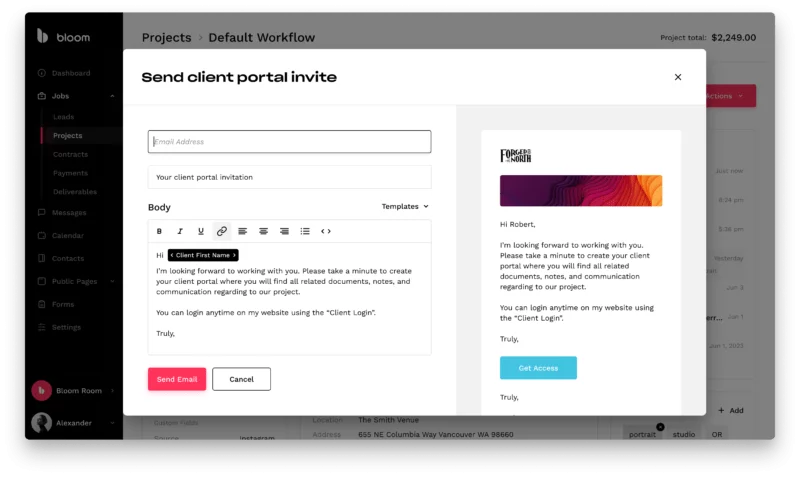
Invite your client to access their project assets, updates, and payment details from Bloom CRM’s customer portal
And the best part? It’s super simple to use, and is specifically designed for creative projects.
Let’s understand this tool better with an example.
| If you’re a freelance photographer, here’s how you can deliver great customer experience with Bloom’s Client Portal: Digitized contracts: Upload contracts to the Bloom portal for clients to review and sign electronically and speed up paperwork Seamless appointment scheduling: Clients can check for available slots and book an appointment for their photo session directly through the portal. No more scheduling conflicts! Proofing and feedback: After a shoot, upload initial proofs to the portal. Clients can view these images, select their favorites, and provide feedback or request specific edits directly. Use this centralized feedback process to understand client preferences more efficientlyQuick invoicing and payments: Generate and send invoices through the portal. Clients can review charges, make payments securely online, and track their payment historyProject tracking: Keep clients updated on the progress of their projects. Through the portal, clients can see when their photos are being edited, when proofs will be available, and when the final images are ready for download |
With Bloom, you can maintain transparency in client relationships, reduce back-and-forth communication, and manage their expectations. Besides making your clients happy, you’ll also save time on admin tasks.
Personalize your services
Being a solopreneur, you have the flexibility to curate your services based on unique customer needs. Use this freedom to your advantage and stand out from bigger competitors.
| For instance, let’s say you’re a graphic designer. A small, boutique coffee shop reaches out to you to revamp its brand identity. Unlike larger design firms with standardized packages, you can personally visit the client’s shop to gain a deep understanding of their ambiance, target clientele, and brand ethos.Based on these insights, you might create a custom logo that reflects the shop’s cozy, artisanal vibe, develop a distinctive color palette that evokes warmth and comfort, and design unique packaging for their coffee products that stands out on shelves. You could also go the extra mile by offering tailored digital assets (social media templates or website graphics) to help the coffee shop build a cohesive online presence. This is a great way to upsell (and increase your AOV) while truly helping your client. |
Also read: CRM for Freelancers: Optimize Your Freelance Business with a CRM
6. Upgrade your skillset and approach
Being curious and open to new perspectives will expand your horizon of knowledge. In turn, you’ll get some food for thought to scale your business.
Leverage new technologies
Back in 2020, none of us anticipated the rise of ChatGPT. Fast forward to 2025, writers, marketers, and professionals across industries have embraced the tool to speed up their workflow. And those who are still on the fence, might be losing out on a great opportunity to make their daily work less tedious.
Speeding up the workflow doesn’t necessarily mean being efficient; it’s also about keeping the quality high. As you take on more clients or collaborators, it’s easy for messages and feedback to get a little messy, which can slow things down and create unnecessary stress. That’s where a tool like Utopia Analytics comes in. It can help keep your digital interactions tidy and respectful, whether it’s client emails, team chats, or shared feedback. That way, your conversations stay on track, your brand stays professional, and you can spend more time focusing on the creative work you love.
| For example, if you’re a marketer, you often have to go through long case studies. With the help of ChatGPT (or any other AI tool you prefer), you can summarize the case study and understand its key points quickly. You save a few hours in a day, which you can devote toward more strategic tasks that require human thinking. |
Invest in yourself
Another big part of adapting to changes is upskilling and keeping yourself up-to-date with the latest knowledge. Prioritize investing in your personal and professional development, be it through books, podcasts, courses, workshops, webinars, or mentorships.
Treat these as business expenses—things you must do to hone your craft, get more clients, deliver stellar work, and most importantly, keep up the motivation to go the extra mile.
Grow Your Business with Bloom
To scale as a solopreneur, you have to balance your core work with the essential admin tasks that drive your sales pipeline.
For streamlining this process, consider Bloom as your go-to tool. This CRM for creatives efficiently handles lead management, project tracking, task management, payments, and more. With the back-end operations taken care of, you can focus on growing your business and nurturing your creativity.
Start your free trial today and explore the possibilities!